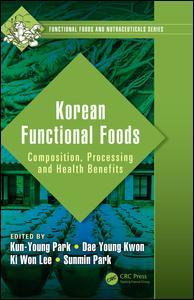Description
Korean Functional Foods
Composition, Processing and Health Benefits
Functional Foods and Nutraceuticals Series
Coordinators: Park Kun-Young, Kwon Dae Young, Lee Ki Won, Park Sunmin
Language: English
Subjects for Korean Functional Foods:
Keywords
Perilla Oil; food as medicine; Bamboo Salt; traditional medicine; HFD; medicinal effects; Red Pepper Powder; Korean dietary custom; HFFs; Functional Food Act; Korean Functional Foods; Cherl-Ho Lee; Functional Foods; Dae Young Kwon; Kimchi Fermentation; Kyung Rhan Chung; 3T3 L1 Adipocyte; Jaehyun Ju; Korean Cuisine; Hak-Jong Choi; Dietary Fiber; Jieun Lee; Fermented Foods; Ja-Young Jang; SOS Chromotest; Eui-Seong Park; Sea Water; Sunmin Park; Functional Ingredients; James W; Daily; Korean Ginseng; Soon-Hee Kim; HT-29 Human Colon Carcinoma Cells; Ok Kyung Koo; DPPH Radical Scavenge Activity; Young Myoung Kim; Fermented Soybeans; Kwang-Soon Shin; Korean Foods; Hoon Kim; Fermented Fish; Boo-Yong Lee; Traditional Korean Foods; Hye-Kyung Na; Fermentation Technology; Young-Joon Surh; AGS Cell; JaeHwan Lee; Red Pepper; Mi-Ja Kim; Mun Yhung Jung; Hyung-Min Kim; Phil-Dong Moon; Na-Ra Han; Hyun-Ja Jeong; Jeong-Yong Cho; Lily Jaiswal; Kyung-Sik Ham; Sanjeewa K; K; Asanka; Hyun-Soo Kim; You-Jin Jeon; Young-Eun Lee; Youn-Soo Cha; Seok-Tae Jeong; Han-Seok Choi; Ji-Eun Kang; Soo-Wan Chae; Su-Jin Jung; Jin-Hee Lee; Ji Yeon Kim; Yeonkyung Lee; Ki Won Lee; Jong Hun Kim; Sanguine Byun; Jong-Eun Kim
· 15.6x23.4 cm · Hardback
Description
/li>Contents
/li>Biography
/li>
Koreans believe the adage of food as medicine. Therefore, herbs or fruit ingredients such as ginger, cinnamon, adlay, mugwort, pomegranate, and ginseng are used for their therapeutic effects as much as cooking. This book provide information related to Korean functional food. It first describes the history and culture of Korean foods, and then compares Korean diet tables with other Asian countries and Western countries. Also, the book will cover detailed information of Korean functional foods such as kimchi, soybean products, ginseng, salt, oil and seeds. It also deals with its health benefits and processing methods, followed by rules and regulations related to its manufacture and sales.
Contents
Preface..................................................................................................................... vii
Acknowledgments..................................................................................................ix
Editors.......................................................................................................................xi
Contributors............................................................................................................xv
1 Korean Foods—History, Culture, and Characteristics............................1
Cherl-Ho Lee
2 Korean Diets and Their Tastes...................................................................23
Dae Young Kwon and Kyung Rhan Chung
3 Kimchi and Its Health Benefits...................................................................43
Kun-Young Park and Jaehyun Ju
4 Lactic Acid Bacteria in Kimchi...................................................................79
Hak-Jong Choi, Jieun Lee, and Ja-Young Jang
5 Health Benefits of Doenjang (Soybean Paste) and Kanjang
(Soybean Sauce)........................................................................................... 101
Kun-Young Park and Eui-Seong Park
6 Cheongkukjang........................................................................................... 145
Sunmin Park and James W. Daily
7 Biological Functions and Traditional Therapeutic Uses
of Kochujang (Red Pepper Paste).............................................................. 165
Dae Young Kwon and Soon-Hee Kim
8 Jeotgal (Fermented Fish): Secret of Korean Seasonings...................... 183
Ok Kyung Koo and Young Myoung Kim
9 Sikcho (Korean Vinegar)............................................................................ 217
Kwang-Soon Shin and Hoon Kim
10 Korean Ginseng: Composition, Processing, and Health Benefits.....233
Boo-Yong Lee
11 Yangnyeom (Spices) and Health Benefits............................................... 257
Hye-Kyung Na and Young-Joon Surh
12 Seed Oil (Sesame Seed, Perilla Seed)...................................................... 291
JaeHwan Lee, Mi-Ja Kim, and Mun Yhung Jung
13 Health Benefit Effects of Jukyeom (Bamboo Salt)................................ 319
Hyung-Min Kim, Jaehyun Ju, Phil-Dong Moon, Na-Ra Han,
Hyun-Ja Jeong and Kun- Young Park
14 Beneficial Effects of Cheonilyeom (a Mineral-Rich Solar
Sea Salt) on Health and Fermentation..................................................... 341
Jeong-Yong Cho, Lily Jaiswal, and Kyung-Sik Ham
15 Edible Korean Seaweed: A Source of Functional Compounds.......... 359
Sanjeewa K. K. Asanka, Hyun-Soo Kim, and You-Jin Jeon
16 Namul, the Korean Vegetable Dish.........................................................385
Young-Eun Lee
17 Bibimbap as a Balanced One-Dish Meal................................................ 421
Youn-Soo Cha
18 Korean Alcoholic Beverages: Makgeolli/Yakju..................................... 441
Seok-Tae Jeong, Han-Seok Choi, and Ji-Eun Kang
19 Clinical Trials of Some Korean Functional Foods................................463
Soo-Wan Chae and Su-Jin Jung
20 Functional Food Industry: Processing and Sanitation........................505
Jin-Hee Lee
21 Regulations of Korean Functional Foods............................................... 523
Ji Yeon Kim and Yeonkyung Lee
22 Future of Functional Foods in Korea....................................................... 539
Ki Won Lee, Jong Hun Kim, Sanguine Byun, and Jong-Eun Kim
Index......................................................................................................................553
Dr. Kun-Young Park is Professor in the Dept. of Food Science and Nutrition,Pusan National University, in Busan, Korea. He earned a food science degree and masters of science at Korea University and completed his PhD in food science at the University of Nebraska . Professor Park’s research interests are 1) Korean traditional foods and their cancer prevention and antiobesity effect and 2) Phytochemicals, functional foods, anticancer and antiobesity. Currently his research is on Korean fermented functional foods, such as Kimchi (Korean fermented vegetables), Doenjang (Soybean fermented paste), Kochujang (Red pepper powder-soybean fermented paste), and their chemopreventive and antiobesity effects. He has published approximately 400 research papers and reviews, and have been invited or presented more than 800 papers at domestic or international symposia.Dr. Kwon received his Ph.D. in Biological Science and Biotechnology from the Korea Advanced Institute of Science and Technology in Seoul in 1986. After finishing his postdoctoral training at the Whitehead Institute, MIT, Cambridge, USA, he has started his research as a research scientist at Korea Food Research Institute (KFRI). He worked at KFRI in the field of food biological chemistry. He worked as adjunct professor at Sookmyung Women’s University in 1997-2003. He is a representative professor of United University of Science and Technology since 2004. He worked as a Director of Emerging Food Technology Division, Director of Food Convergence, etc. in KFRI. In 2014, he was the president of KFRI. After resigning his position, he worked as an Editor-in-Chief of Journal of Ethnic Foods published by Elsevier and vice-president of Korean Society of Foods and Nutrition. He has studied the anti-metabolic syndrome, and anti-aging food. He had experience to collaboration work with Institute of Food Research (IFR), Norwich, UK. He has published more than 250 research papers in several renowned SCI internationa




